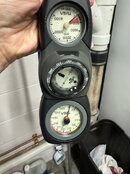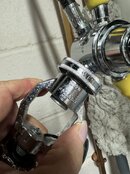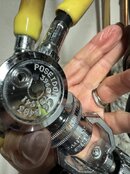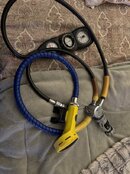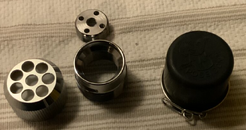Thanks for the mention!
To reprise much of what's been said above,
you indeed have a solid set there - a 3960, which continues to be sold today.
Whether or not it is worth the expense of servicing is up to you, but there is a solid set of divers that love the Jetstream/3960.
I would be happy to service it for you, to get it up to speed! No one will take more care of your regs than I (and I am an authorized West Coast Service Center for Poseidon).
Now the caveats...
You have a bit of a Frankenset there. I don't know your diving experience, so I apologize if my comments are obvious.
First, there is only one second stage. Today, we dive with an auxiliary second, mostly to be able to hand off a breathing source to a buddy in distress. While you could add virtually any brand second to the set, it MUST be tuned to the supply pressure (IP) from the first stage, which is slightly lower than most brands. A second Jetstream would be more typical (and I'd be happy to sell you a good used Jetstream). Interestingly, the attached Jetstream is yellow, which suggests that originally, there WAS a second reg attached.
While there are special hoses that used to be required for the Jetstream, due to its valve, your 3960 has a pop-off, or OPV, there on the bottom, so you can use any hose with a Jetstream adapter.
If your yellow Jetstream was stored with the Dive/Predive switch in the "-" position, you may be looking at a new diaphragm, and a new servo valve is not uncommon if reg maintenance hasn't been perfect. That's another $100 in parts.
The 3960 has one weakness if stored wet. The carrier for the diaphragm can corrode and prevent sealing. The valve piston commonly needs polishing or replacement due to pitting.
And finally, the first stage is a DIN type, with a yoke adapter on it. The very first thing I'd do after you read this, is see if you can disconnect the adapter from the DIN fitting by grasping the wheel while you try to unscrew the adapter.
If you can't, and the two are really corroded together, it may be a challenge to disassemble the reg without permanently damaging the DIN bolt. More parts $$.
I also note that it is a console set. Most divers today are carrying computers, which may render one or two of the gauges redundant.
In short, servicing the set as it currently stands, is nominally ~$140, with (somewhat costly Poseidon first stage kits) and labor including spool service of your console SPG.
If you add the price of another used, but serviced Jetstream, and every single one of the misfortunes mentioned above affects you, it may max out at as much as $430 plus postage. DM me if you want to discuss further...




